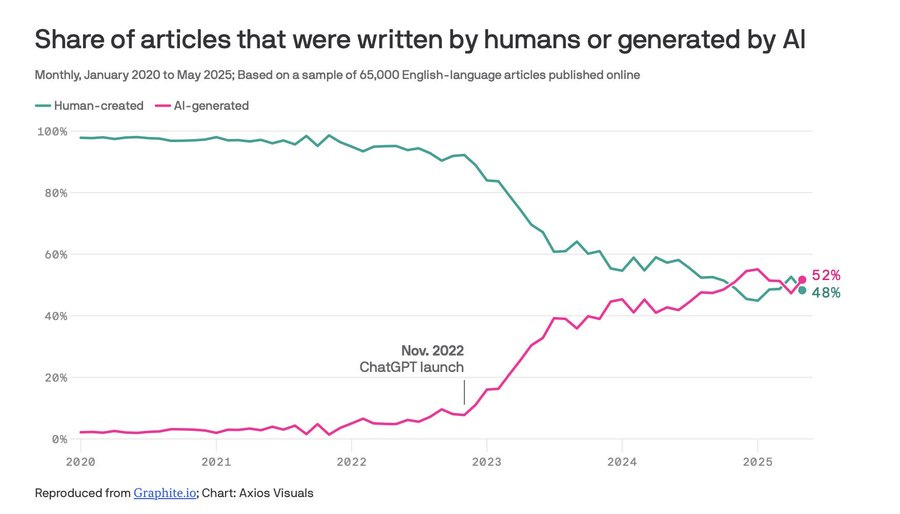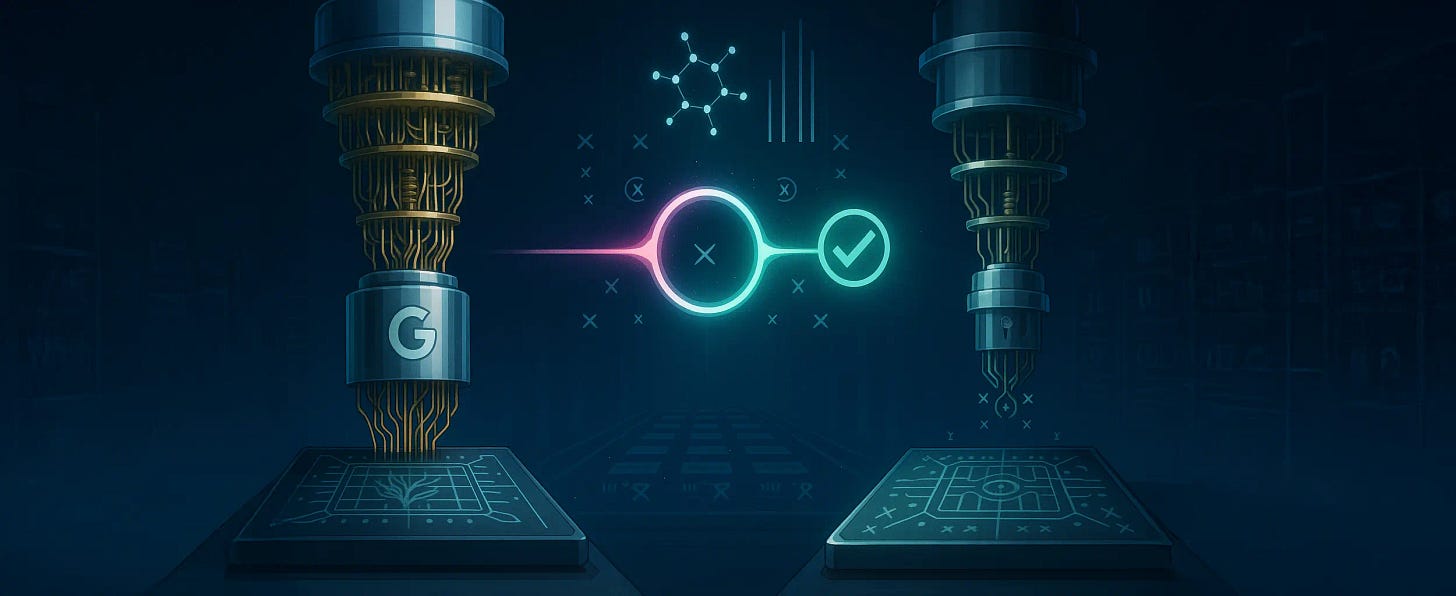🧠 Half the Web Is AI Slop, 🧬 Quantum Breakthrough, 📉 Wikipedia Traffic Falls
AI now writes half the public web, Wikipedia traffic drops 8%, and Google claims a 13,000× quantum speedup.
✨ What’s your AI creative stack?
I’m helping bring GenAI Lab’s first Brisbane event to life — GenAI Powered Creative Stack. on Thu 30 Oct, come along to a practical evening on how humans and AI co-create, with real case studies, clear frameworks, and Q&A.
On stage
Emma Barbato: AI influencer in the wild and what audiences buy
Jamie van Leeuwen: creative production at speed with standards
Gareth Rydon: how to brief and control agents for real outcomes
📅 When: Thu 30 Oct
🕕 Time: 5:30 pm for a 6:00 pm start
📍 Where: The Precinct, Level 2, 315 Brunswick St, Fortitude Valley QLD 4006
🎟️ Tickets: https://events.humanitix.com/genai-powered-creative-stack
🎵 Podcast
Don’t feel like reading? Listen to it instead.
By the way, if you like the podcast. Please let me know (20 seconds).
📰 Latest News
Half the web is machine-written. Search is already punishing the slop
Fresh data suggests AI-generated writing and human-written articles now sit at rough parity on the open web, after a brief period where AI output overtook human content around May 2025. The chart comes from Graphite’s sampling of URLs and AI-detector scoring, summarised by Axios this week. The method is indicative, not definitive, since detectors are imperfect and some AI text is edited by humans before publication. Even so, the economics are clear. The marginal cost of machine text trends toward zero, while human reporting and editing remain costly. The quality gap shows up in search. Publishers that scaled pure AI articles have often seen ranking penalties and traffic loss.
Why it matters:
Search and recommendations: As AI text increases, ranking systems lean harder on provenance, authorship and on-site engagement to separate useful work from low-value output. Expect more weighting for first-party expertise and verified sourcing.
Economics of content: Near-zero marginal cost tilts incentives toward volume. That pushes platforms and advertisers to reward signals of originality and accountability, not word count.
Data supply and “model collapse”: Oxford researchers warned that training models on their own outputs degrades performance over time. As the public web fills with synthetic text, the cost and compliance burden of sourcing human, attributable data rises. The long-term bottleneck becomes high-quality, human-origin corpora.
Operational guardrails: Teams should tag synthetic copy internally, gate what flows into fine-tuning sets, and build capture pipes for verified human material. Otherwise tomorrow’s models overfit to today’s AI slop.
Editorial strategy: Human-led reporting, expert bylines and transparent citations remain defensible. Purely synthetic listicles are already being down-ranked.
Quantum breakthrough: Google’s Willow and “Quantum Echoes” leave supercomputers behind
Google says its Willow quantum chip has run a new algorithm, “Quantum Echoes,” that performs a calculation apparently beyond reach of classical machines and, crucially, yields a result that can be efficiently checked by another quantum computer. The team reports a speed-up of roughly 13,000× versus the best classical method on one of the world’s fastest supercomputers, with the work published this week and framed as the first verifiable quantum advantage. The experiment targets an out-of-time-ordered–correlator–style “echo” that captures how information scrambles in a quantum system; Google ties the signal to nuclear magnetic resonance features that reveal interactions inside molecules, pointing to eventual pay-offs in drug discovery and materials science.
Why it matters:
Most prior “quantum advantage” claims were either too artificial to be useful or too hard to verify at scale. If Quantum Echoes holds up under replication on independent hardware, it represents a move away from stunt benchmarks toward tasks with direct scientific value and a verification path that does not require re-running months of classical computation. That could shorten the loop from quantum experiment to chemical insight, especially if echo-style protocols become a standard primitive for probing molecular structure. The caveat is scope: today’s win is narrow, verification as described needs another capable quantum device rather than a laptop, and full fault tolerance remains ahead; experts note practical applications still require far larger, more stable systems. Even so, a verifiable speed-up on a physics-linked task is a meaningful step beyond random-circuit showpieces.
AI overviews are eating Wikipedia’s clicks. Human pageviews fell 8%.
Wikipedia says human page views are down about 8 per cent year on year, after it retuned bot-detection and stripped out traffic from aggressive crawlers. The Wikimedia Foundation links the decline to AI search summaries and social video, where users get answers sourced from Wikipedia without clicking through. The update was published last week on Wikimedia’s official blog and echoed in tech press coverage.
Why it matters:
Attention is moving from open-web visits to AI overviews and bots pulling content in the background. For publishers, traditional metrics like page views understate real consumption and weaken funding models tied to on-site engagement. For Wikipedia, fewer clicks can mean fewer edits and donations, despite its content powering AI answers. For AI developers, this intensifies questions about attribution, link-back and paid access to high-value sources.
The world is more wary than wowed by AI. Pew’s 25-country pulse shows concern winning
Pew’s latest global survey (25 countries, Jan–Apr 2025) finds caution outweighs excitement about AI. A median 34 per cent are more concerned than excited about AI in daily life, 42 per cent are equally concerned and excited, and 16 per cent are more excited than concerned. Older adults, women and people with less education are more likely to be concerned. In Australia—as in the U.S., Italy, Brazil and Greece, about half say they are more concerned than excited. No country’s largest share is “more excited than concerned.”
Why it matters:
This sets a clear baseline: the public mood is cautious, not euphoric. For governments, that sentiment gives political cover for tighter AI rules. For companies, it means adoption will hinge on trust features (privacy, accuracy, recourse) rather than hype. And for researchers, the demographic splits point to where literacy and safeguards will have the most impact, especially among older and less-connected users. Expect uptake to track demonstrations of real-world benefit and credible risk controls, not claims.
Prime-time provocation: Channel 4 lets an AI front the news and it is deeply uncanny
Channel 4’s Dispatches special Will AI Take My Job? aired in the UK on 20 October 2025 with an AI-generated host, later revealed on-screen as “Aisha Gaban.” The experiment was produced by Kalel Productions and is now available to stream on Channel 4’s platform.
Channel 4’s head of news and current affairs, Louisa Compton, said this is not a move to routine AI presenters; the goal was to test audience response and spark debate. Coverage and reviews highlight a deliberate “twist” reveal that drew Black Mirror comparisons and mixed reactions.
Why it matters:
Putting a synthetic presenter on a national current-affairs slot makes automation tangible for a mainstream audience and tests disclosure norms. It surfaces near-term questions for broadcasters—editorial accountability, credits, union considerations—while Channel 4 signals more controlled experiments ahead rather than wholesale replacement.
ChatGPT becomes a checkout. Walmart plugs buying straight into the chat
Walmart has partnered with OpenAI so shoppers can buy inside ChatGPT, not just find products. Customers will be able to link their Walmart or Sam’s Club account, browse the catalogue in conversation and hit a Buy button to complete the order without leaving the chat. The feature runs on ChatGPT’s Instant Checkout and is rolling out in the United States, with Walmart positioning this as an “AI-first” shopping experience.
Under the hood, payments ride on Stripe and the open Agentic Commerce Protocol, which OpenAI and Stripe co-developed so AI agents can initiate and complete purchases securely. Instant Checkout launched in the US in late September and is expanding from Etsy and soon Shopify merchants to large retailers. Reports indicate support for saved cards and express wallets, with account linking handled in-app.
Why it matters:
This is the first serious test of chat-native purchasing at big-box scale. Moving discovery, decision and payment into one conversation collapses the funnel and reduces the role of search pages and app navigation. If the experience proves faster and more accurate than tapping through mobile menus, a share of product finding shifts from retailer sites and marketplaces into assistants, which changes how brands earn visibility.
In a chat interface, ranking is governed by model relevance and merchant metadata rather than paid shelf space, so assortment quality, clean feeds and structured product data become as important as bid strategy.
Walmart gains a direct lane into ChatGPT’s audience while keeping fulfilment and customer relationship on its rails, which is the key to preventing the agent from owning the customer. For OpenAI, every successful purchase trains a new habit that could divert future shopping intent away from general search. The direction is clear, ChatGPT is not just a place to ask about products. It is becoming a place to buy them.








